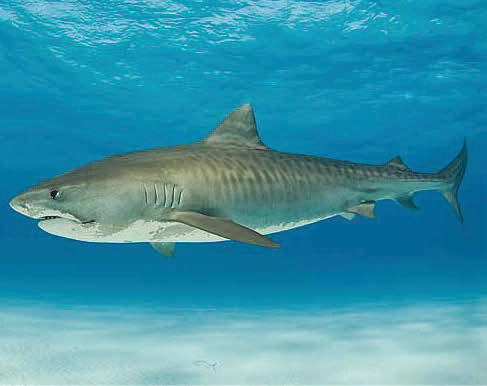Tiger Shark
Tiger shark
Galeocerdo cuvier
Description

| Length 4-6.5m |
Weight 520kg |
Lifespan 50 years |
Tiger sharks’ broad, blunt snouts have strongly curved teeth. Stripes on the back are prominent on young but fade to nothing on adults. Their angular, hooked tail allows it to twist and turn rapidly to catch fast prey. It has a large brain and sophisticated sensory system, including excellent eyesight, taste and smell. Tiger sharks are most active during the day and more numerous when the water is warmer and prey are plentiful.
Diet

Prey include sea snakes, dugong and dolphin calves, cormorants, turtles, smaller sharks and rays. Receptors along the shark’s sides sense vibrations and water pressure changes. Pores in the snout detect close-range electrical fields generated by the muscles of prey. Tiger sharks can find rays buried in sand and sense whether potential prey are healthy or wounded.
Breeding

| Gestation 9 months |
No. young 60 |
Sexually mature 6-8 years |
Sharks grow slowly, take a long time to mature and produce relatively few young. A tiger shark breeds about once every two years and females give birth to live young (pups). While most other fish produce lots of small eggs that are fertilized outside the body, sharks produce large eggs which are fertilised internally. Males use claspers to deliver sperm to the female.
Distribution

Tiger sharks occur world-wide in tropical and warm temperate oceans. A tiger shark may swim between shallow coastal habitats and deep open-ocean environments. Few other shark species show such flexibility.
Status
Tiger sharks are vulnerable to many threats. Many sharks die trapped in fishing nets and others are killed out of fear, or for sport, food, fins and other resources. The loss of individuals in species like this that reproduce slowly is felt more keenly than in species that reproduce rapidly.
Fact sheet
SHARK BAY
World Heritage



